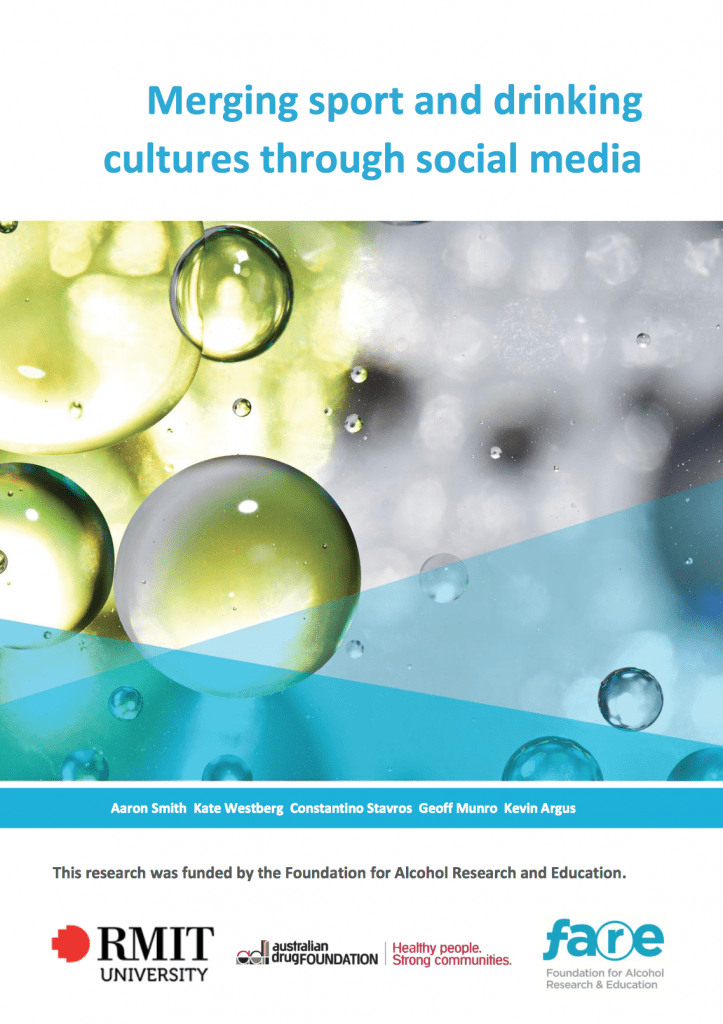A new study from Australia’s Foundation for Alcohol Research and Education reveals that the alcohol industry is aggressively investing in the use of social media channels. Their strategic purpose:
- To normalise and glamorise alcohol use and
- To perpetuate the myth of alcohol being an integral part of sporting experiences.
The study that we briefly introduce here, was funded by the Foundation for Alcohol Research and Education and undertaken by RMIT University, Melbourne.
Up to 85% of fans use social media during sporting events, and up to half of viewers use their smart phones or portable devices to check scores or watch highlights.
Social media encourages fans to engage with brands: such as liking Facebook posts or sharing a status and photo.
“With alcohol brands historically well-versed in marketing communications activities and early adopters of the power of social media and broader digital platforms, we suggest that a powerful triumvirate of sport, alcohol and social media is emerging,” said Kate Westberg, one of the authors.
“The use of digital marketing in sport, including social media platforms, reflects a new mindset where the conventional distance between sport properties, their marketing representatives, and fans is completely blurred, and where success means constant adaptation.
“No longer are digital tools just ‘add-ons’ to the standard marketing methods. Today, a digital world means a digital message, and that message is infused with commercially driven alcohol promotions.”
The study focused on major alcohol brands sponsoring the Australian Football League (AFL), National Rugby League (NRL) and Australian Cricket, because of the high attendances, TV broadcasts, and ‘strong cultural significance in Australian society.’ Alcohol brands were noted as ‘prominent sponsors’ of these events.
In their analysis, the scientists found four strategies employed by the alcohol industry, per FARE, the Foundation for Alcohol Research and Education:
- Call to compete:
Using the competitive nature of sport, brands attempt to engage consumers through promotional competitions with sport-related prizes displaying both sport and alcohol branding. - Call to collaborate:
Stimulating co-creation of content, or user-generated content using sport as a common language. - Call to celebrate:
Using sporting victory and shared camaraderie, this seeks to embed alcohol as an integral part of celebrating and basking in the reflected glory of a win. - Call to consume:
This strategy seeks to embed alcohol intake as part of a consumer’s sport consumption practices and social interactions.
The impact and effectiveness of these calls is facilitated through the use of messages designed to resonate with the target consumer. The calls to action comprise the mechanisms used by alcohol brands through social media, and the themes of identity, culture and camaraderie give their communications the power to embed alcohol as part of the consumer’s sport identity and sport experience. The ultimate goal appears to be to merge alcohol culture with sport culture.
The key considerations for policy makers can be summarised as follows:
- What type of social media content, and frequency, is appropriate for alcohol brands that seek to leverage their association with sport?
- What forms of collaboration and interaction which link sport and alcohol are appropriate for consumers to engage in?
- Are the messages linking sport and alcohol, particularly those that invite consumer collaboration or interaction, more likely to appeal to minors than other types of content or messages? Are there adequate safeguards in place to prevent minors from accessing social media content linking sport and alcohol?
- What mechanisms can be used to monitor social media activity by alcohol brands, particularly the less transparent activities which occur through consumer networks?
For further reading #1: “Merging sport and drinking cultures through social media” (PDF), Foundation for Alcohol Research and Education, 2015.
For further reading #2: RMIT University

